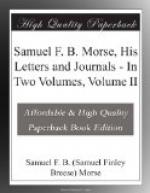“Why not come to Charleston? Here is a fine place for usefulness, a pleasant climate especially for persons advanced in life, and your children here; for I think seriously of settling in Charleston. Lucretia is willing, and I think it will be much for my advantage to remain through the year. Richard can find a place here if he will, and Edwards can come on and be Bishop or President or Professor in some of the colleges (for I can’t think of him in a less character) after he has graduated.
“I wish seriously you would think of this. Your friends here would greatly rejoice and an opening could be found, I have no doubt. Christians want their hands strengthened, and a veteran soldier, like papa, might be of great service here in the infancy of the Unitarian Hydra, who finds a population too well adapted to receive and cherish its easy and fascinating tenets.”
All this refers to a movement organized by the enemies of Dr. Morse to oust him from his parish in Charlestown. He was a militant fighter for orthodoxy and an uncompromising foe to Unitarianism, which was gradually obtaining the ascendancy in and near Boston. The movement was finally successful, as we shall see later, but they did not go as far from their old haunts as Charleston.
I shall not attempt to argue the rights and wrongs of the case, which seem to have been rather complicated, for Dr. Morse, more than a year after this, in writing to a friend says: “The events of the last fifteen months are still involved in impenetrable mystery, which I doubt not will be unravelled in due time.”
The winter and spring of 1819 were spent by the young couple both pleasantly and profitably in Charleston. The best society of that charming city opened its arms to them and orders flowed in in a steady stream. Mr. John A. Alston was a most generous patron, ordering many portraits of his children and friends, and sometimes insisting on paying the young man even more than the price agreed upon.
In a letter to Morse he says: “Which of my friends was it who lately observed to you that I had a picture mania? You made, I understand, a most excellent reply, ’You wished I would come to town, then, and bite a dozen.’ Indeed, my very good sir, was it in my power to excite in them a just admiration of your talents, I would readily come to town and bite the whole community.”
And in another letter of April 10, 1819, Mr. Alston says: “Your portrait of my daughter was left in Georgetown [South Carolina], at the house of a friend; nearly all of the citizens have seen it, and I really think it will occasion you some applications.... Every one thought himself at liberty to make remarks. Some declared it to be a good likeness, while others insisted it was not so, and several who made such remarks, I knew had never seen my daughter. At last a rich Jew gentleman observed, ‘it was the richest piece of painting he had ever seen.’ This being so much in character that I assure you, sir, I could contain myself no longer, which, spreading among the audience, occasioned not an unpleasant moment.”




